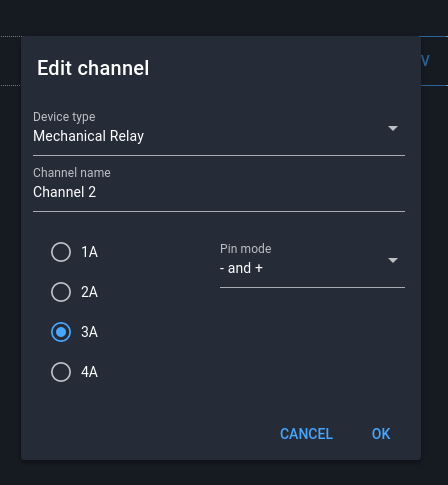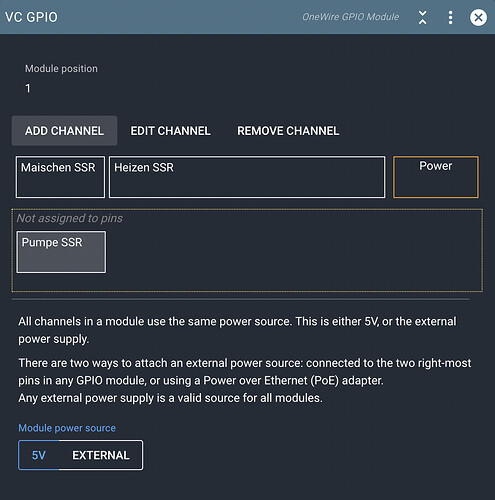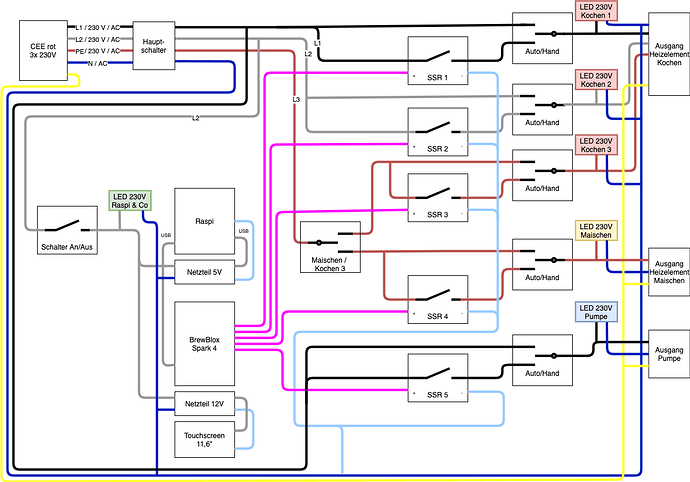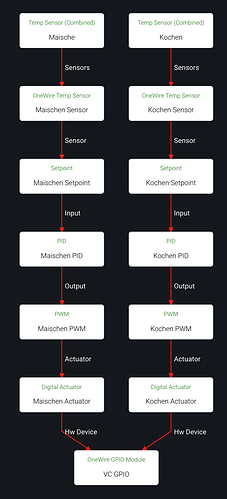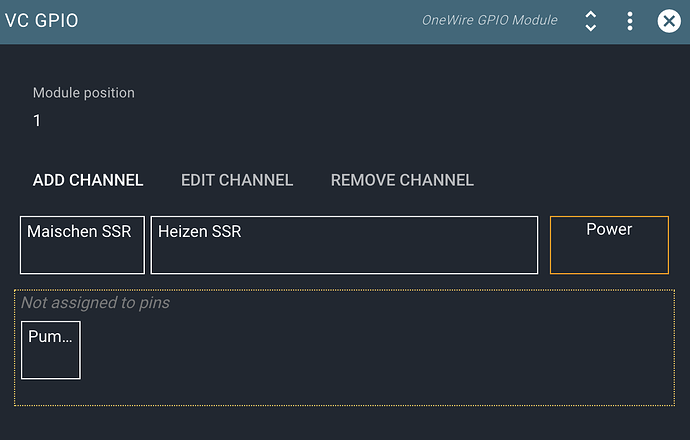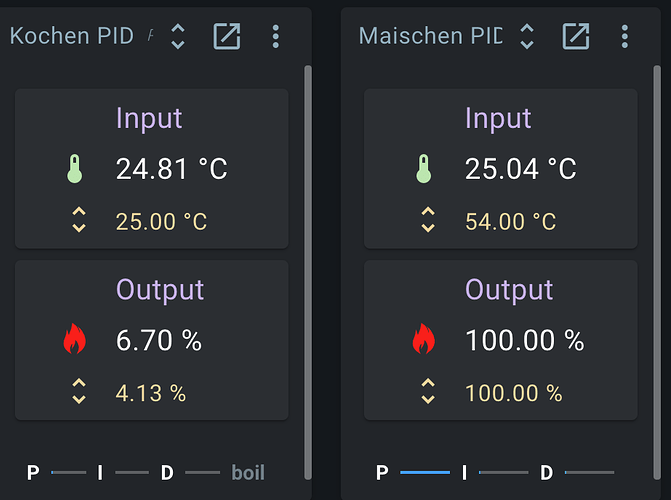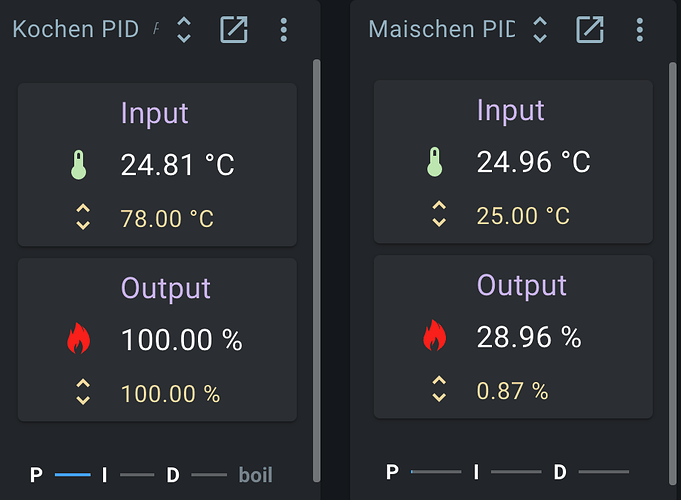Thanks Bob.
I now get the relays switched. Unfortunately, the system behaves a bit strange. When the boiling kettle reaches and holds the temperature, the mash relay also switches on and off constantly, although the temperature is far from being reached.
“blocks”:[{“nid”:101,“groups”:[0],“type”:“ErrorObject”,“data”:{“error”:“DecodeError(Field number 0 is illegal.)”,“type”:“TempSensorOneWire”},“id”:“Kochen Sensor”,“serviceId”:“spark-one”},{“nid”:102,“groups”:[0],“type”:“ErrorObject”,“data”:{“error”:“DecodeError(Field number 0 is illegal.)”,“type”:“TempSensorOneWire”},“id”:“Maischen Sensor”,“serviceId”:“spark-one”},{“nid”:112,“groups”:[0],“type”:“ErrorObject”,“data”:{“error”:“DecodeError(Field number 0 is illegal.)”,“type”:“TempSensorCombi”},“id”:“Kochen”,“serviceId”:“spark-one”},{“nid”:113,“groups”:[0],“type”:“ErrorObject”,“data”:{“error”:“DecodeError(Field number 0 is illegal.)”,“type”:“TempSensorCombi”},“id”:“Maische”,“serviceId”:“spark-one”},{“nid”:7,“groups”:[7],“type”:“ErrorObject”,“data”:{“error”:“DecodeError(Field number 0 is illegal.)”,“type”:“DisplaySettings”},“id”:“DisplaySettings”,“serviceId”:“spark-one”},{“nid”:106,“groups”:[0],“type”:“ErrorObject”,“data”:{“error”:“DecodeError(Field number 0 is illegal.)”,“type”:“Pid”},“id”:“Maischen PID”,“serviceId”:“spark-one”},{“nid”:109,“groups”:[0],“type”:“ErrorObject”,“data”:{“error”:“DecodeError(Field number 0 is illegal.)”,“type”:“Pid”},“id”:“Kochen PID”,“serviceId”:“spark-one”},{“nid”:114,“groups”:[0],“type”:“Balancer”,“data”:{“clients”:[]},“id”:“Balancer”,“serviceId”:“spark-one”},{“nid”:115,“groups”:[0],“type”:“ErrorObject”,“data”:{“error”:“DecodeError(Field number 0 is illegal.)”,“type”:“Mutex”},“id”:“Mutex”,“serviceId”:“spark-one”},{“nid”:100,“groups”:[0],“type”:“ErrorObject”,“data”:{“error”:“DecodeError(Field number 0 is illegal.)”,“type”:“OneWireGpioModule”},“id”:“VC GPIO”,“serviceId”:“spark-one”},{“nid”:105,“groups”:[0],“type”:“ErrorObject”,“data”:{“error”:“DecodeError(Field number 0 is illegal.)”,“type”:“ActuatorPwm”},“id”:“Maischen PWM”,“serviceId”:“spark-one”},{“nid”:116,“groups”:[0],“type”:“ErrorObject”,“data”:{“error”:“DecodeError(Field number 0 is illegal.)”,“type”:“DigitalActuator”},“id”:“Maischen Actuator”,“serviceId”:“spark-one”},{“nid”:110,“groups”:[0],“type”:“ErrorObject”,“data”:{“error”:“DecodeError(Field number 0 is illegal.)”,“type”:“ActuatorPwm”},“id”:“Kochen PWM”,“serviceId”:“spark-one”},{“nid”:117,“groups”:[0],“type”:“ErrorObject”,“data”:{“error”:“DecodeError(Field number 0 is illegal.)”,“type”:“DigitalActuator”},“id”:“Kochen Actuator”,“serviceId”:“spark-one”},{“nid”:103,“groups”:[0],“type”:“ErrorObject”,“data”:{“error”:“DecodeError(Field number 0 is illegal.)”,“type”:“SetpointSensorPair”},“id”:“Kochen Setpoint”,“serviceId”:“spark-one”},{“nid”:107,“groups”:[0],“type”:“ErrorObject”,“data”:{“error”:“DecodeError(Field number 0 is illegal.)”,“type”:“SetpointSensorPair”},“id”:“Maischen Setpoint”,“serviceId”:“spark-one”}],“store”:[{“keys”:[“ActiveGroups”,1],“data”:{}},{“keys”:[“SystemInfo”,2],“data”:{}},{“keys”:[“SystemTime”,3],“data”:{}},{“keys”:[“DisplaySettings”,7],“data”:{}},{“keys”:[“VC GPIO”,100],“data”:{}},{“keys”:[“Kochen”,112],“data”:{}},{“keys”:[“Maische”,113],“data”:{}},{“keys”:[“Kochen PID”,109],“data”:{}},{“keys”:[“Maischen PID”,106],“data”:{}},{“keys”:[“OneWireBus”,4],“data”:{}},{“keys”:[“WiFiSettings”,5],“data”:{}},{“keys”:[“TouchSettings”,6],“data”:{}},{“keys”:[“SparkPins”,19],“data”:{}},{“keys”:[“Balancer”,114],“data”:{}},{“keys”:[“Mutex”,115],“data”:{}},{“keys”:[“New|ActuatorDigitalInterface-1”,104],“data”:{}},{“keys”:[“New|ActuatorDigitalInterface-2”,111],“data”:{}},{“keys”:[“Maischen Actuator”,116],“data”:{}},{“keys”:[“Kochen Actuator”,117],“data”:{}},{“keys”:[“Kochen PWM”,110],“data”:{}},{“keys”:[“Kochen Setpoint”,103],“data”:{}},{“keys”:[“Kochen Sensor”,101],“data”:{}},{“keys”:[“Maischen PWM”,105],“data”:{}},{“keys”:[“Maischen Setpoint”,107],“data”:{}},{“keys”:[“Maischen Sensor”,102],“data”:{}}]}
